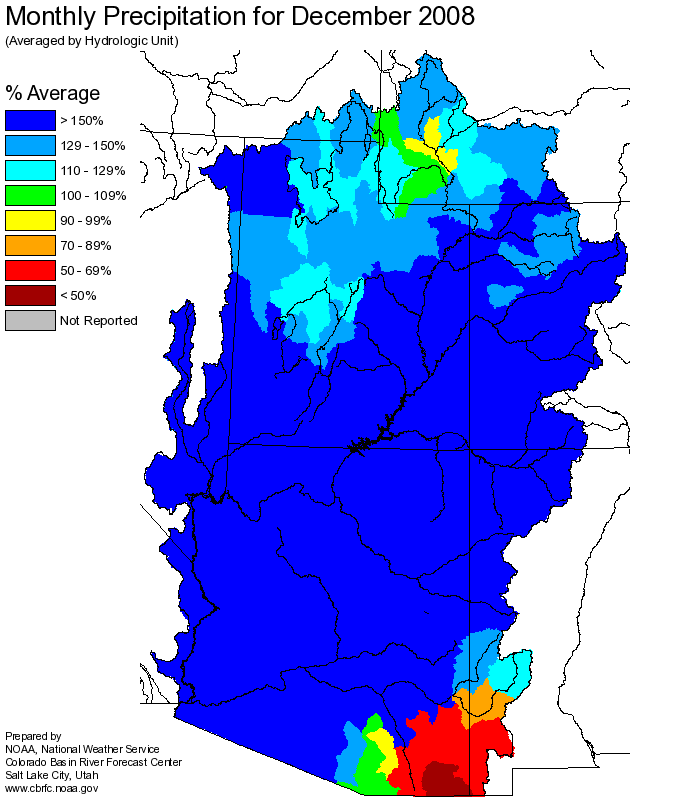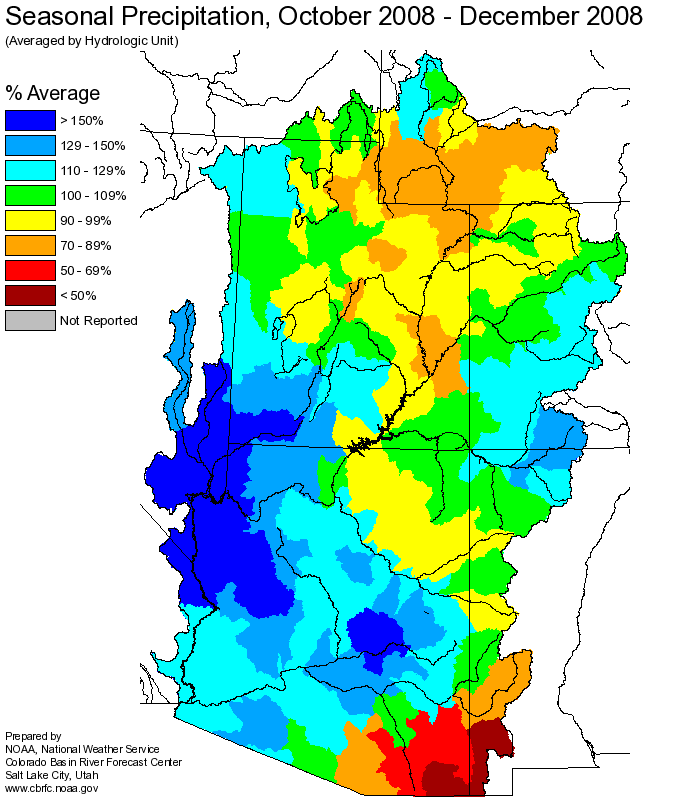Note: This publication is currently undergoing major revisions. The current publication will be replaced with a new publication based on stakeholder requirements and scientific advances. We expect to begin sharing details on this soon. If you have input on content, format, or publication frequency at any time, please contact us at cbrfc.webmasters@noaa.gov.Lake Powell Water Supply Outlook, January 1, 2009Lake Powell Water Supply Outlook, January 1, 2009
Contents
Lake Powell Sub-Basin Summaries
Modeled soil moisture continues to indicate much below and below average conditions for most of Green River Basin.
(Click for November 1st image) This signal is
incorporated in the
ESP model guidance utilized by the CBRFC in generating our forecasts. At the time of this publication,
seasonal precipitation is near normal for most of the region. Snowpack ranges from average to below average in the major
tributaries of the Green River.
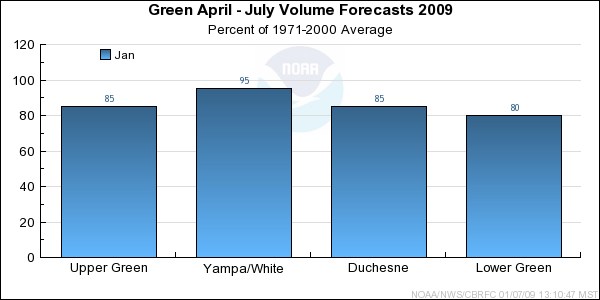
*Median of forecasts within each basin.
After a somewhat dry start to the water year, December precipitation was much
above average in the Upper Colorado, Gunnison and Dolores basins. This brought
the seasonal precipitation to just above average in all basins and the January
1st snow water equivalent to much above average.
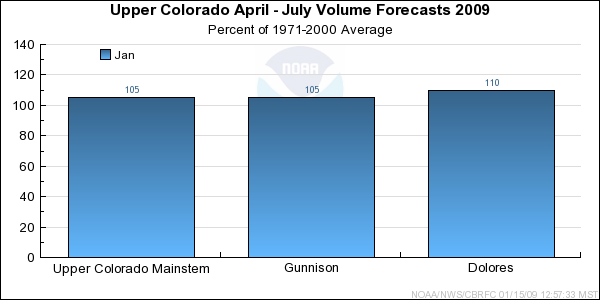
*Median of forecasts within each basin.
-Model Soil Moisture/Observed Streamflow...Soil moisture for most of the upper basins in the San Juan
were below average in the fall. This was most likely due to limited monsoonal precipitation over the
summer months. Observed streamflow for the month of December was mostly below average for the San Juan.
-Snowpack/Precipitation...Snowpack above Navajo Reservoir is currently 130 percent of average
while the Animas was 135 percent. Precipitation over the San Juan Basin for December was much above
average with 220 percent. Seasonal average precipitation for the San Juan Basin increased to 115 percent.
-Short Term Precipitation Forecast...The forecast models through next week keep the San Juan Basin
relatively dry with near average temperatures.
-General Discussion...The current snowpack and statistical forecast suggest the April-July forecast of
115 to 120 percent of average. However, the ESP guidance suggests a forecast of around 110 percent of
average due to lower than average soil moisture. The CPC guidance continues to show the possibility of
increased chances of below average precipitation for January through March across the San Juan Basin.
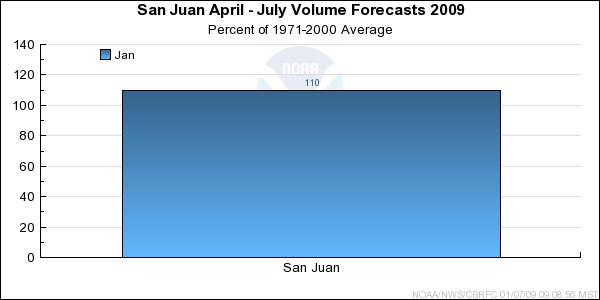
*Median of forecasts within each basin.
Upper Green Basin Conditions
Despite above average December precipitation, the snow water equivalency in the Upper Green Basin remains below
average. Low snowpack combined with the basin wide much below average soil moisture conditions resulted in ESP
model guidance near 80% of the April through July average. While the antecedent soil moisture conditions will not
change prior to runoff, there is ample time to accumulate snow in the upper basin. With this in mind, forecasts were kept at
the upper bound of guidance levels for points in the Upper Green resulting in near-to and below-average volume predictions.
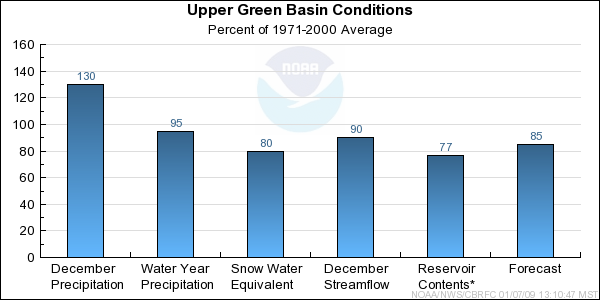
* Percent usable capacity, not percent average contents.
Click for multi-month Graph.
Yampa/White Basin Conditions
Currently, the Yampa and White River basins has the highest snowpack observations with most Snotel stations indicating average
or above average values for January 1st. While soil simulations indicate drier than average conditions in portions of this
region, headwater basins have near average conditions. Soil moisture deficits are not adversely effecting model guidance as much as in other
regions. April through July forecast indicate near average runoff volumes for the Yampa and White basins.
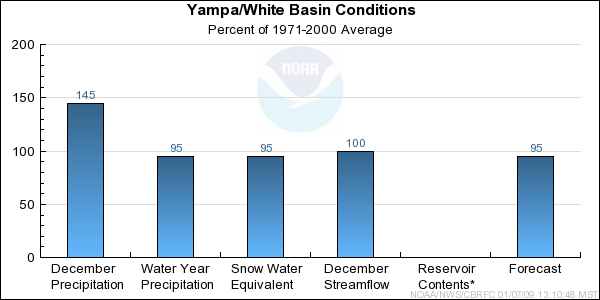
* Percent usable capacity, not percent average contents.
Click for multi-month Graph.
Duchesne Basin Conditions
December precipitation was 140 percent of average. This brought the Snowpack in the Duchesne Basin from 37 Percent of average
on December 1st to 85 percent of average on January 1st. However, some Snotel stations located in the Eastern portion of the Uinta South slope
report below average conditions. Soil conditions in the Duchesne are similar to he Upper Green with many basins indicating much
below average conditions. Forecasts range near average on the headwaters of the basin to below average at downstream locations.
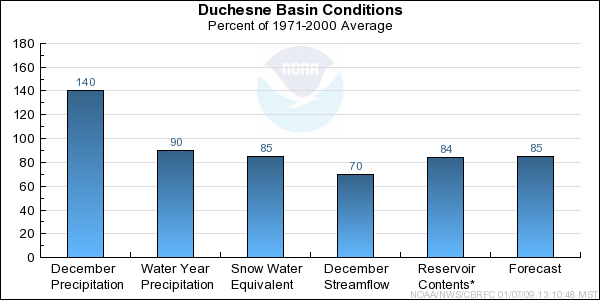
* Percent usable capacity, not percent average contents.
Click for multi-month Graph.
Lower Green Basin Conditions
The Lower Green Basin has the lowest snowpack in the Green Basin as of January 1st. Despite this, forecasts range from near average to below average.
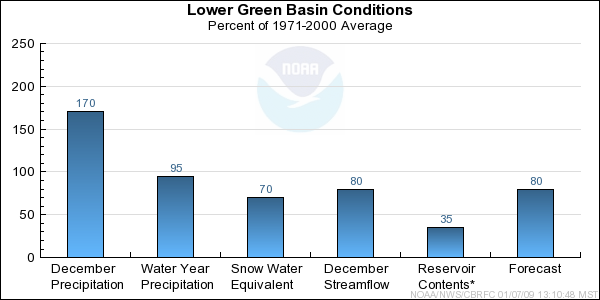
* Percent usable capacity, not percent average contents.
Click for multi-month Graph.
Upper Colorado Mainstem Basin Conditions
December precipitation was 170% of average in the Upper Colorado mainstem basin,
which made up for a rather dry start to water year 2009. As of January 1st, the
overall basin snow water equivalent was 125% of average. The snowpack is not
uniform across the basin; the areas on the northern side of the basin, bordering
the White and Yampa basins, have snow water equivalent percentages not quite as
high as those in the areas on the southern side of the basin, which border the
Gunnison basin. The Roaring Fork basin has the highest snow water equivalent
with over 140% of average. Model soil moisture was near normal heading into the
winter and December streamflow was also near normal. The April through July
streamflow forecasts range between 92% and 116% of average at this time.
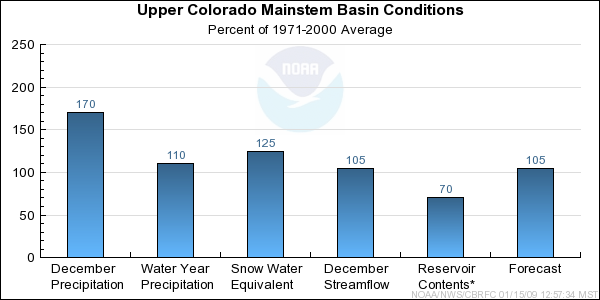
* Percent usable capacity, not percent average contents.
Click for multi-month Graph.
Gunnison Basin Conditions
-Model Soil Moisture/Observed Streamflow...Soil moisture for most of the upper basins in the Gunnison
was near to slightly below average in the fall. Observed streamflow for the month of December was near
average for the Gunnison.
-Snowpack/Precipitation...As of January 1st, snowpack across the Gunnison was 130 percent of average.
Precipitation over the Gunnison Basin for December was much above average with 210 percent. Seasonal
average precipitation for the Gunnison increased to 115 percent.
-Short Term Precipitation Forecast...The forecast models through next week keep the Gunnison Basin
relatively dry with near average temperatures.
-General Discussion...The current snowpack and statistical forecast suggest the April-July forecast of
105 to 110 percent of average. However, the ESP guidance suggests a forecast of near average due to
slightly lower than average soil moisture. The CPC guidance continues to show the possibility of
equal chances of above or below average precipitation for January through March across the Gunnison
Basin.
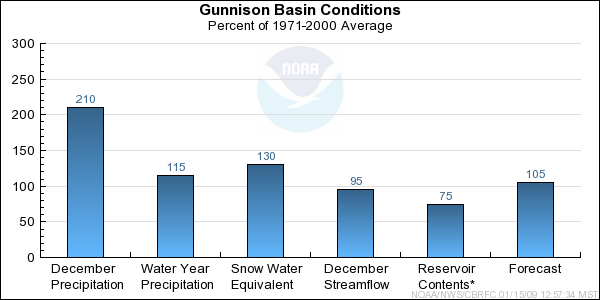
* Percent usable capacity, not percent average contents.
Click for multi-month Graph.
Dolores Basin Conditions
-Model Soil Moisture/Observed Streamflow...Soil moisture for most of the upper basins in the Dolores
were below average in the fall. This was most likely due to limited monsoonal precipitation during the
summer months. Observed streamflow for the month of December was mostly below average for the Dolores.
-Snowpack/Precipitation...As of January 1st, snowpack across the Dolores is currently 145 percent of
average. Precipitation over the Dolores Basin for December was much above average with 235 percent.
Seasonal average precipitation for the Dolores Basin increased to 115 percent.
-Short Term Precipitation Forecast...The forecast models through next week keep the Dolores Basin
relatively dry with near average temperatures.
-General Discussion...The current snowpack and statistical forecast suggest the April-July forecast of
115 to 120 percent of average. However, the ESP guidance suggests a forecast of around 110 percent of
average due to lower than average soil moisture. The CPC guidance continues to show a possibility of
below average precipitation for January through March across the Dolores Basin.
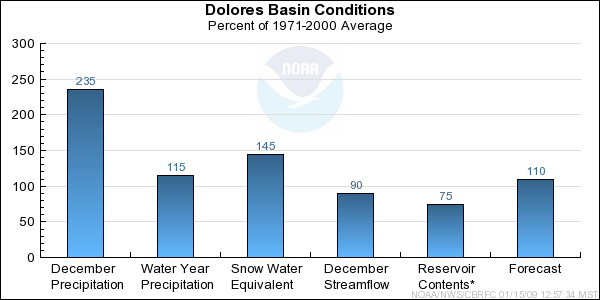
* Percent usable capacity, not percent average contents.
Click for multi-month Graph.
San Juan Basin Conditions
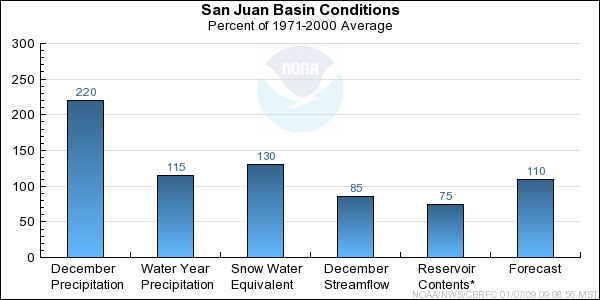
* Percent usable capacity, not percent average contents.
Click for multi-month Graph.
Differences between the full period forecasts and the residual forecasts may not exactly equal the actual observed volumes due to rounding conventions (see Definitions section).
Reservoir Monthly Inflow Forecasts
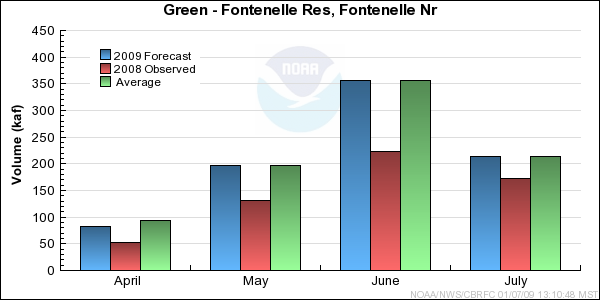
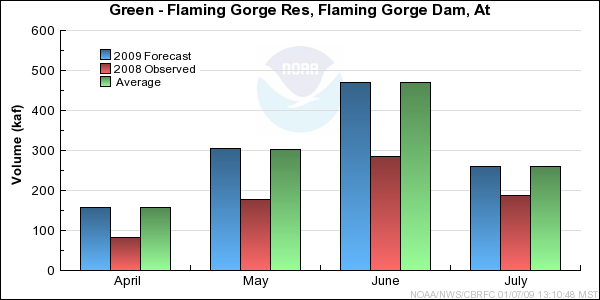
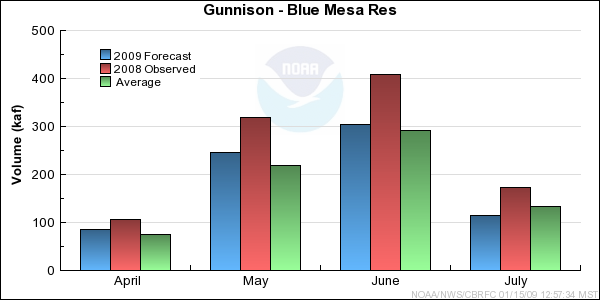
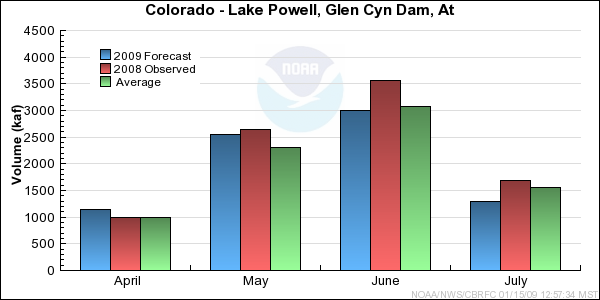
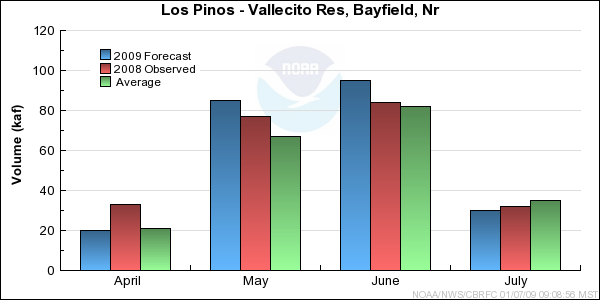
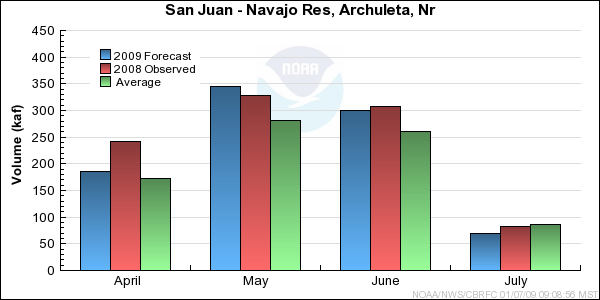
Monthly Streamflows
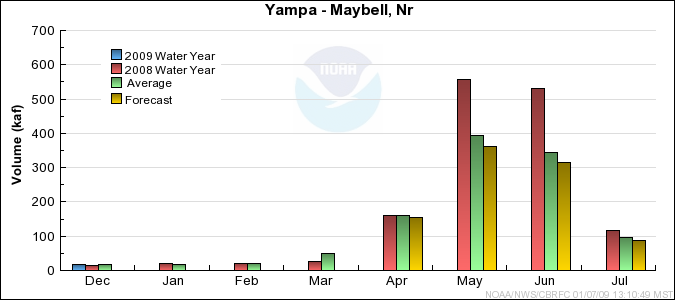
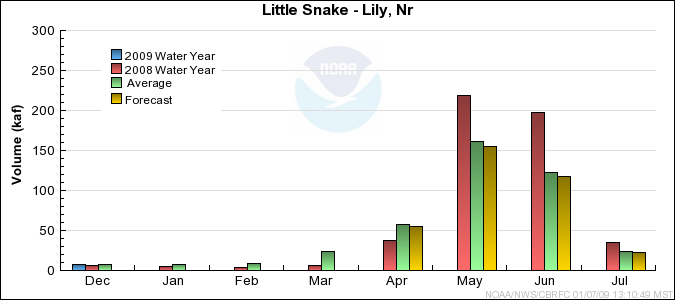
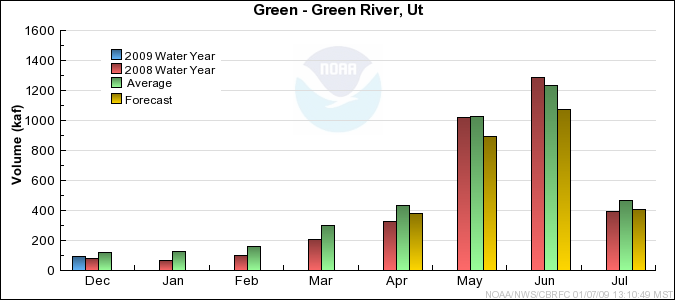
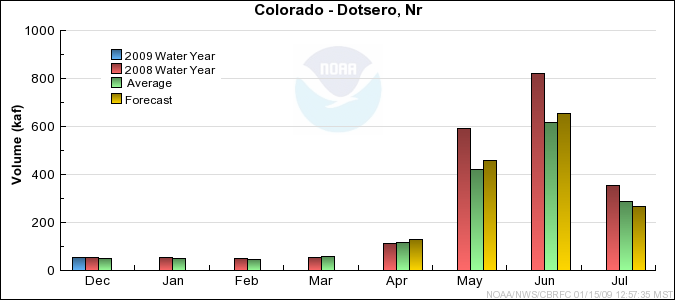
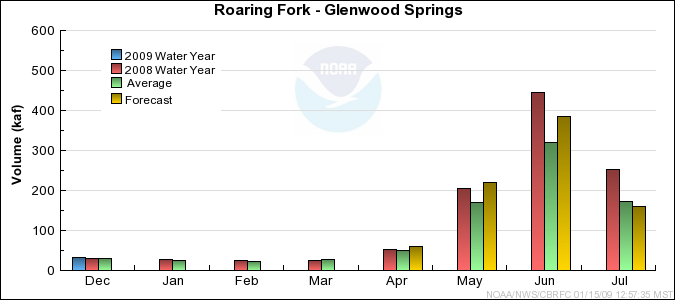
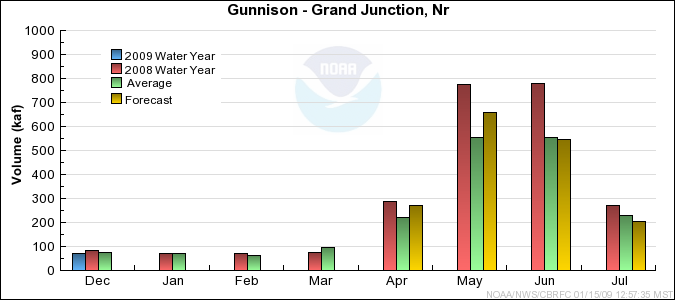
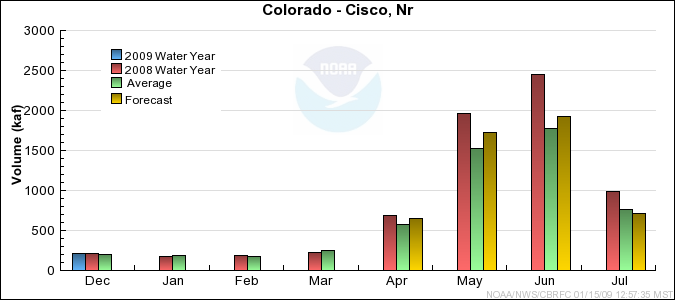
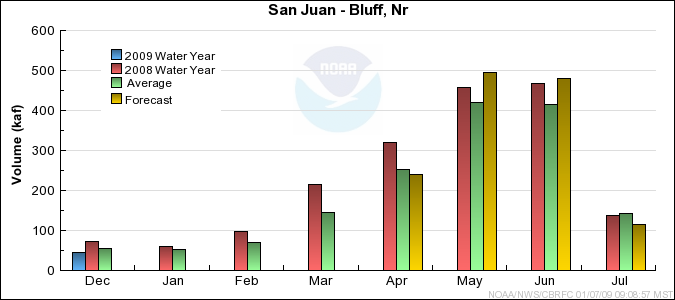
Precipitation Maps
